
Alan Christy is Associate Professor of History, Cowell Provost, and Co-Director of the Center for the Study of Pacific War Memories at UC Santa Cruz. Among other things, his work explores the complexities of Okinawan history and the ways in which trajectories of imperialism, anthropological thought, and public memory intersect. In tandem with this, Christy is also the Director of the Okinawa Memories Initiative (OMI)—which serves as the inspiration for his contribution to our 2021 Memory Series. OMI is a spirited collaboration of college students, researchers, oral historians, and artists based at UC Santa Cruz and working in partnership with Cal State Monterey Bay, CSU East Bay, and communities in Okinawa. Christy’s piece explores the ethos of this project, the ways in which it is situated in global currents, and the enormity of “small” places.
Okinawa Isn’t Small
Let me pin my anxiety to the top of this essay, so I can get on with it. I have been traveling to and studying Okinawa since 1992 and I don’t know yet if I have important things to say. This is not the tired, time-worn statement of white visitors to “The East” who paradoxically re-affirm their expertise on “Asia” by citing its impenetrable mysteries, still denying them mastery despite their many years of experience and investigation. My anxieties in writing this lean more to the side of wondering whether my voice is one that needs to be heard now. Yet, I continue to work on Okinawa, overly ambitiously, in the hopes of making a difference.
The Targeted Village
It comes back to a trip I took to Okinawa in 2013, my first exploration of the viability of the project that has now become The Okinawa Memories Initiative. I had just been presented with a set of photos taken in Okinawa in 1953 by an American serviceman (more on that shortly) and I was meeting with the museum director and curators at the Okinawa Prefectural Museum and Art Museum, the lead archivist at the Okinawa Prefectural Archives and a colleague at the University of the Ryukyus to see whether these photographs sparked any interest in them as they had in me. My meeting at the Prefectural Museum had gone well. The director and staff liked the photos and we explored some of the possibilities of one day doing a show at one of the Citizen’s Galleries. That night, when I got back to my hotel, I got a message from one of the staff at that meeting. She said that if I wanted to continue to work with them, she needed me to go see a just-released documentary film that was playing at the art house theater on Sakurazaka in Naha. Of course I went.
The film is called The Targeted Village (Hyôteki no mura), directed by Mikami Chie in 2013. While addressing the overall situation at that time regarding anti-base activism in Okinawa, it focused especially on the efforts of a small group of people in the northern town of Takae who were struggling against the construction of a helipad that could be used for the Osprey that the American military was set on introducing to its bases on the island. The activists had built lives of peaceful, cooperative agricultural stability that was about to be mowed down by the US-Japan military alliance that couldn’t seem to get enough out of its bases in Okinawa. Throughout the film, we watch the activists take every route available to them in a democratic system to resist the construction of the helipad, from advocacy, to protest, to electoral politics and, eventually lawsuits. Of course, it was all to no avail. The helipad, as well as the expanded Camp Schwab base at Henoko, would have to be built. It may be unpleasant, the residents of Takae were told, but it was a sacrifice they would have to make for the security of the nation and the stability of the region. The bitterness with which that message was received was illuminated by a story of the last time the US Military had created an installation in the area during the Vietnam War.
As a historian of Japan and Okinawa, I could contribute my research to the effort, but I felt the need to give the microphone to Okinawans.
The northern half of Okinawa is composed of relatively tall, steep volcanic mountains covered with thick “jungle” vegetation. From the point of view of the U.S. Military, the area presented conditions similar to the terrain in which their forces were currently fighting in central Vietnam. So they constructed a jungle warfare training area in the mountains and forest surrounding Takae, including a fake Vietnamese village that new troops could use for training in counter-insurgency maneuvers. The military even hired local Okinawans, only 20 some years out from their own experience of warfare in the Battle of Okinawa, to “act” as Vietnamese peasants whose village could be raided, whose homes could be searched and whose bodies could be constrained by new recruits. The “actors,” the film revealed, were paid in food.
As the activists battled their own government and the U.S. Military, the memories of that time when they were forced to act as Vietnamese insurgents were still searingly alive, even as their opponents in the Japanese government acted as if such a thing had never happened. As Japanese officials dismissed their concerns as insignificant—this was a small sacrifice after all, and when had they done anything comparable to the people who lived closer to the giant base complexes in the central and southern part of Okinawa?—the activists had a longer memory of continual demands for “sacrifice” for a greater good beyond their own lives. As the trial of three of the leaders, accused of trespassing and property damage, came to an end with convictions, one of them looks to the camera at the end of the film and asks “What will it take for us to be heard? We have done everything we can do in a democracy and still we are not heard.” (a paraphrase from my own memory). I left the theater with a searing sense of responsibility to play some role in helping Okinawan voices be heard. As a historian of Japan and Okinawa, I could contribute my research to the effort, but I felt the need to give the microphone to Okinawans.
Fishmongers
As I said, I was in Okinawa at that time with a set of photos that I, myself, had really only just begun looking at. They had been brought to me by Shelby Graham, director of the Sesnon Gallery, and Geri Gail, our campus auditor at the time. Geri was nearing retirement and she had approached Shelby about the possibility of doing a show at the Sesnon of some of her father’s photographs. Her father, Charles Eugene Gail, had been a dentist with a passion for photography. Over the course of decades, Gene had taken his camera out to the streets and the mountains to work on his photographic skills, shooting scenes in LA, at the Monterey Pop Festival and in the Sierras. Geri recalls sitting with him in his darkroom as he processed his film and printed his photos. She remembers him going through his shots with her, critiquing his photos, tossing about 90% out as not good enough. He never left his profession as a dentist, but as his granddaughter Laura taught me, he aspired to create art. And he worked hard on it. He had passed away in 2003, and as Geri was getting ready to leave the university, she hoped to honor those efforts with a show. Of all the work he left in his home in Coos Bay after he passed, it was the 150 or so photos he took while stationed in Okinawa in 1953, working as a dentist and administrator at the hospital in Torii Station, in Yomitan village, Okinawa that remained his favorites. For years his family and his patients had seen the photos on the walls of his study and his offices.
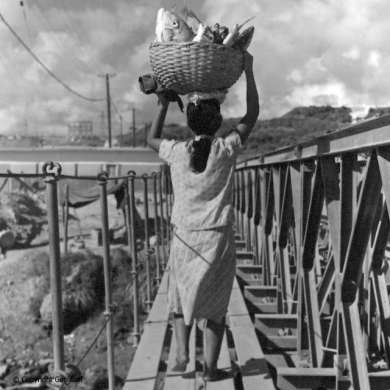
Photo Credit: Charles Eugene Gail
Shelby recognized Gene’s skills, but also wanted to know whether these photos might have any historical interest. She contacted Stacy Kamehiro in HAVC, a specialist in Oceania, and Stacy recommended that they come talk to me. As I looked through the photos, I saw right away that there was little record here of a history of events in Okinawa at the time. Amidst the undoubtedly charming scenes of pastoral landscapes and people on the streets (or dirt roads), there was a glaring absence of the U.S. Military presence—no bases, no soldiers, no camp towns and bars. The general feel was consistent with the photographic style that dominated the “Family of Man” project run by MoMA’s Edward Steichen, also in the mid-50s. But amongst the photos was one that took my breath: a woman walking barefoot, over a makeshift metal bridge with a giant basket of fish on her head, an urban space awaiting her on the horizon. I had just written an article about the fishmongers of Itoman, a fishing village on the southern tip of Okinawa, a couple years ago and immediately felt a shiver of recognition and the weight of that woman’s story hovering near the photo.
Back in 1937, the Ministry of Justice in a Japan that was now at full-scale war in China, ordered its district courts to undertake hearings on local economies and cultures that might make the justices—all appointed by the central government—more sensitive to adjudicating in local conditions. District courts in other parts of Japan held hearings on festivals, or sericulture, on marriage practices and so on. But the district court in Naha held just one hearing, “On the So-Called Individualistic Families of Itoman.” It turns out that a Marxist economist, Kawakami Hajime, had written an infamous article in 1910 about the fishing families of Itoman and how the women and the men kept separate accounts of their earnings and property. Put simply, the men fished, and the women met the men at the shore, received the fish, carried them twelve kilometers up the coast to the urban market in Naha-Shuri, and then paid the men the “market price” for the fish at their return home. Sell above the market rate (or set the market rate at an appropriate level, since the women decided amongst themselves at a mid-point on the way home from Naha what the market price had been for that day) and the women could generate profits that they would keep for themselves. This was, by the way, strictly speaking, illegal in pre-war Japan, since all property was to be controlled by the male head of the household. The Naha District Court was aware of Kawakami’s article and decided to hold a mock trial of the women of the village to determine whether they were good Japanese citizens, or potentially dangerous ideological deviants. Of course the women were not at the mock trial. They were represented by the principal of the local elementary school.
When I saw that photo and thought of Kawakami and that 1937 mock trial, I thought of the stories I had still not yet heard from the women themselves. I said to Geri and Shelby that while the photos had no historical events, they gave us opportunities to hear all kinds of stories from everyday Okinawans about their lives in the twentieth century. Okinawans famously have long life expectancies. Surely, if we take these photos to Okinawa, we’ll find people who lived these scenes, if not the people in the photos themselves. We can encourage them to tell us about their lives. I proposed a project that would be a combination of exhibition and oral history, one that would be carried out by a team of students, faculty and staff from UC Santa Cruz in collaboration with partners in Okinawa.
The World of Private Memories
The more time I spend with the Gail photos, especially in the company of Okinawans, the more I see going on in them. But the absence of the American Military continues to haunt. Others, especially Americans, have noticed that (somehow, most Okinawans I’ve spoken with seem unconcerned, probably because it is no more than they would have expected, having been the subjects of others’ gazes for so long). We know, in fact, that the presence of the US Military was heavy and inescapable for most Okinawans. Despite a loud narrative of the gifts of peace and prosperity from the American presence, this history of postwar Okinawa is shot through with crime, violence, intimidation and catastrophe. Knowing some part of that, there has often been an expectation on the part of viewers that Gail was hiding that dimension and that some of that experience for Okinawans can be read in the photos that show faces that are concerned, annoyed or even frightened.
On that first exploratory trip in 2013, when I met with my friend Prof. Kina Ikue of the University of the Ryukyus and showed her the photos, I told her that I had warned Geri that it was quite possible that her father’s photographs could elicit hard, painful memories of the American presence for many Okinawans. The loving intentions behind her father’s photos and her own support for the project could result in pain and harsh critique. I admit I was surprised, therefore, when Ikue waved me off. “Not really,” she said. “They are more likely to elicit nostalgia.” She explained that there was a thriving discourse in Okinawa of public memories of the postwar years, but almost no public discussion of the private dimensions of people’s lives.
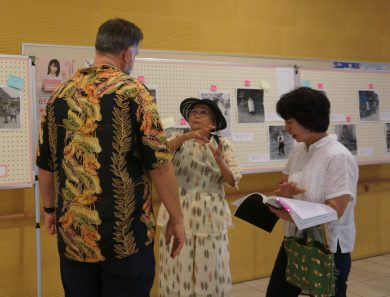
Photo Credit: Kimberly Szeto
Ikue, it need hardly be stated, obviously knows the place better than I do, for her prediction has proven correct over and over. In the exhibitions we have held in community centers throughout the island in the summers of 2018 and 2019, I have seen and heard, time and time again, the discussions among our, now, thousands of visitors, about personal stories and family histories. I recall seeing an older man transfixed by a photo of a thatch-roofed house, while his 50-ish son watched him as intently. It was a photo we threw in there as an example of the range of photos Gene had shot. I had actually thought it as rather typical of an American’s exoticizing gaze. Eventually the son left his father to come to me and say, “My father built those houses. None of them were around anymore by the time I came around. This is the first time I’ve seen them with him.” I recall a woman in her mid-80s, side-stepping my ginger attempts to engage her in conversation until she stood in front of one photo showing squid drying on a line. She beckoned me over and said, simply, “This is the truth.” (kore ha shinjitsu da.) I recall spending nearly two hours in the lobby of the Urasoe City Hall with another elegantly-dressed woman in her mid-80s, accompanied by her Japanese (not Okinawan) son-in-law as she recounted story after story of her survival of the war, her struggles to rebuild her life afterwards, of the places in the islands she had lived, of the lessons she had had to teach her Japanese son-in-law about how to live in a place where you can “drop your spirit.” (mabui wo otosanaide, ne?) At one point near the end, she pointed to a simple landscape photo and said, “I’ve had no occasion to think about any of this. We had nothing then and we’ve nothing left from those days.” I recall the fishermen and women of Henza explaining all the variety of boats in Gene’s coastal pictures, another set that had simply eluded my ability to discern details. Every boat, no matter how humble, had a clear function, name, history and models in the glass cases lining the fishing cooperative where we put the photos on display. What had been “boats” to me had been entire lives to them, with routes, goods, passengers, calculations of tides and master boat builders.
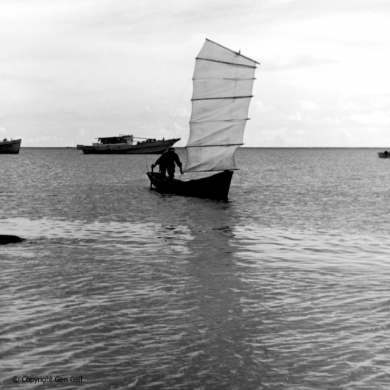
Photo Credit: Charles Euguene Gail
We have had one truly hair-on-the-back-of-the-neck-raising find so far. In 2018, I did an interview with a reporter from the Ryukyu Shimpo and at the end she asked for some photos to run with the piece. I chose a photo that was a closeup of two children staring directly into the camera as one of the offerings, in the hopes that one of the children would recognize themselves. The next day, indeed, the reporter called to say a woman had contacted her to say, “I’m the girl in the photo. The one with the severe expression (kibishii kao).” That photo was one of the photos most likely to draw American viewers to speculate on the fear in the girl’s eyes and her possible traumatizing experiences with American soldiers. So when Alice Yang, Kubota Tomoko, Julia Jen and Tosh Tanaka went to interview her, the first question they asked was about that look of fear. Was she afraid of the American soldier or the camera? The woman, Arakaki Masako, laughed. “I wouldn’t have known what a camera was. I was probably thinking ‘This kid on my back is heavy.’” She went on to tell a story of her childhood, wandering alone through the villages surrounding Futenma Marine Air Station. Her father dead in the battle, her mother and older brother off working to keep the family alive, 9 year-old Masako was drafted by every mother in the village struggling to manage their own families to be an on-the-spot babysitter. Hating every moment, Masako could barely pass through the village without having to carry someone’s kid on her back…until she found refuge in a missionary church, where she got respite and Jesus. “It’s terrible to say this,” she ventured, “but without the war and those mothers, I probably wouldn’t have found God.”
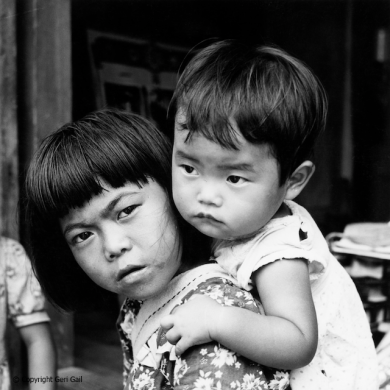
Photo Credit: Charles Eugene Gail
Erasures
The destruction of the Battle of Okinawa was comprehensive, a coldly clinical way to say everything was laid to waste. About one quarter of the population had been killed. Most of the documentary record of the history of the Ryukyuan kingdom (and the shorter-lived Okinawa Prefecture) had been burned up. Much of the architectural heritage of the islands—Shuri Castle, Enryaku-ji, Naminoue and Futenma Shrines—and the physical structures of the urban spaces of central and southern Okinawa lay in rubble. In areas of the most intense fighting, the biota of the island had been stripped away by shelling, napalm and flame throwers. Coming at the end of an “island-hopping” campaign, American Construction Brigades (Cee-bees) began immediately to transform captured land into air bases from which an invasion of the Japanese “home islands” could be launched, erasing via bulldozer, the traces of village life and the traces of family homes and properties. In the intensity of the battle, the Japanese military even targeted the languages of Okinawa for eradication.
In the weeks and months after the Japanese surrender, as nearly the entire civilian population of the island sat in internment camps, awaiting release back to their home villages, or release from the camps to unfamiliar terrain, both the materials and the time/mental space needed to do the work of remembering what had been lost were gone. In the face of a nearly total erasure of familiar ground and memory resources, facing a future whose outline could barely be imagined, struggling simply for daily survival, memory work may have felt too traumatizing or too trivial.
In choosing Okinawa as their last target prior to an invasion of the “Japanese home islands,” the Joint Chiefs of Staff charged the Office of Strategic Services to do a study of Okinawa to determine who the Okinawan people were and what challenges an invasion would face. The OSS report, issued in June of 1944, argued that the Okinawan people were not really Japanese, that they were a conquered and oppressed people. An invasion of the islands by the Americans could be framed as a liberation of the Okinawans. The troops should be trained to recognize the difference between Japanese occupying forces and native Okinawans. They should kill the former and spare the latter.
Of course, it didn’t really pan out that way. Sometimes, yes. Mostly no. The killing was pretty indiscriminate. Nevertheless, US forces maintained, at the policy level, a commitment to treating the Okinawans as a liberated people who might need help recovering from their experience of Japanese occupation. The camps in which the civilian population sat while many had their villages erased under tarmac for new airfields, were presented as spaces of rescue and safety, even as disease and hunger and terrifying uncertainty held sway. As the camps closed and as Okinawans returned to their home areas, or moved to new home villages, and as Okinawa was politically severed from Japan, becoming a trust territory of the US, the US authorities offered programs and institutions to “restore” Ryukyuan culture and create stronger ties with the US.
In the face of a nearly total erasure of familiar ground and memory resources, facing a future whose outline could barely be imagined, struggling simply for daily survival, memory work may have felt too traumatizing or too trivial.
Many Okinawans recognized the cynicism behind this policy. The emphasis on recovering a lost Ryukyuan heritage, destroyed by the relentless assimilation policies of Imperial Japan, was merely a way of keeping Okinawa locked in the American sphere, maintaining it as a space in which the US Military would not have to rely on the advice and consent of a host country government to use the bases as they saw fit. And so, even as the American authorities pushed policies for the recovery of Ryukyuan culture more aggressively, a movement to “revert” back to prefectural status under the postwar democratic state grew. Reversion activists recognized that whatever problems they’d had with prewar and wartime Japan, postwar Japan had a constitution and a democracy. The only hope for political self-determination was under the Japanese “Peace Constitution,” not the U.S. Military Government. Under the intense political struggles of the 1950s and 1960s—paralleled by the desperate efforts to rebuild a functioning economy—it was not often easy to do memory work in Okinawa that was not at risk of appropriation to either American or Japanese narratives of what Okinawans were really supposed to be. A space of self-determined Okinawan self-hood was hard to find. The actual reversion that took place on May 15, 1972 (50 years ago next year) began to open up that space.
The Okinawa Memories Initiative is not at all responsible for the current embrace of Okinawan self-determination and self-knowledge. It should (but won’t) go without saying that the embrace is not without many lines of tension and contestation which, frankly, is what I think makes it healthy. We were lucky that we brought our photos and our recorders to a place where this work is held as deeply meaningful. In 2017, our team went to the Citizen’s Galleries at the Okinawa Prefectural Museum and Art Museum, the place I had first contemplated with the Museum director, Asato Susumu, in 2013. We got to talking with three older women whose painting group was doing an exhibition of their work. We showed them our “carry-into-the-field” printout of Gene’s photos and as they flipped through the book, they became more animated. Finally one looked at us and, waving her arms, exclaimed, “Things have changed so much! You have no idea how much things have changed!”
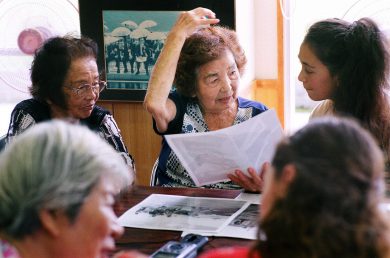
Photo Credit: Tosh Tanaka
Measuring that change, through the photos, through people’s memories of their intimate lives as sparked by the photos, along with the imperative to foreground Okinawan voices in this has been the mission of the Okinawa Memories Initiative. But at the end of this long essay, I want to conclude with a musing on whose memories are Okinawan.
Who Has An Okinawan Memory?
If there is any lesson that has been driven home to me during this project, it is that Okinawa looks small—it fits between Santa Cruz and San Francisco, with a population of about one million—but it is actually big. Prior to WWII, Okinawa had the second highest number of outbound migrants in all of Japan (Hiroshima was the number one “out-sending” prefecture). Okinawans moved throughout the Pacific, notably to Hawai’i, Saipan, Tinian, Palau, Taiwan and the Philippines. They moved to the continental US, but they moved, in larger numbers to Peru, Bolivia, Brazil and Argentina. In the postwar years, especially the main recovery years, those overseas Okinawans played huge roles in rebuilding the economy and the institutional infrastructure. For example, Americans like to remember the establishment of the first university in Okinawa as their doing, but it was done so at the planning and aggressive push of Okinawan Hawai’ians. As tiny Okinawa navigates its place between the superpowers of the US, Japan and, increasingly, China, one might imagine the contest to be hopelessly imbalanced. But in other ways, those with a commitment to the islands’ survival and thriving have included those extended families abroad as well as a remarkable number of migrants to Okinawa from elsewhere, especially the Philippines, India, Taiwan and, yes, the US.
We start with an explanation of Okinawa because we anticipate that our audience doesn’t know it, or sees it as small and, perhaps, not rising to the level of extended scrutiny. I’ve been trying to suppress that instinct lately. Okinawa isn’t small. It’s huge.
I think of Stan Rushworth, a Native American writer and veteran who, as a young recruit in the early 1960s was stationed in Okinawa where he found company, amidst the deep-rooted racism of his fellow Americans, among Okinawan street kids and elders. In an event hosted by the Okinawa Memories Initiative in December 2020, on the fiftieth anniversary of the Koza Uprising, Stan talked about how, as a kid, his familiarity and contact with the Indian culture and elders of his childhood had been stripped away by an American educational system determined to “assimilate” the Indian by eradicating their difference. It was in Okinawa, he told us, that he began that reconnection as he found, especially in Okinawan elders, the attitudes and world views of his own people of his childhood. Stan did not stay in Okinawa. It was a place he passed through for a short time. But Okinawa stayed with him, as he relates in his recent memoir, Diaspora’s Children.
Given what Okinawa and its people meant to Stan, to many other American veterans who made families and lives in and with Okinawans (see Night in the American Village by Akemi Johnson for nuanced stories of the impact of the place on the lives of people not ethnically Okinawan), given what Okinawa means to the young “Shimanchu” (people of Okinawan descent) in Hawai’i, Brazil and elsewhere, the Okinawa Memories Initiative seeks to understand that experience of change and that variety of voices on a global scale.
The other day I met a young woman whose grandmother is Okinawan Hawai’ian. She talked about growing up calling herself “Japanese American,” and then saying, “well, really, Okinawan.” That phrasing was because of her reasonable expectation that most Americans wouldn’t know where Okinawa is, or know anything about the relationship of Okinawa to Japan. This is the experience we in the project have had over and over. Start with an explanation of Okinawa because we anticipate that our audience doesn’t know it, or sees it as small and, perhaps, not rising to the level of extended scrutiny. I’ve been trying to suppress that instinct lately. Okinawa isn’t small. It’s huge.
“Okinawa Isn’t Small” is part of The Humanities Institute’s 2021 Memory Series. This series features contributions from a range of faculty and emeriti in the Humanities community at UC Santa Cruz – each of whom highlight connections between memory and their work or meditate on memory’s relevance in our current moment. Throughout Spring quarter, be sure to look for these amazing essays in our weekly newsletter!